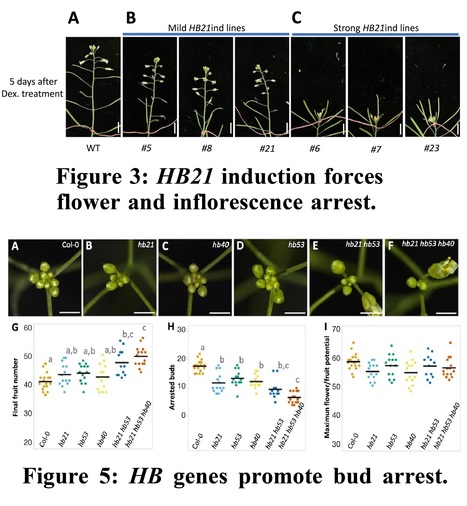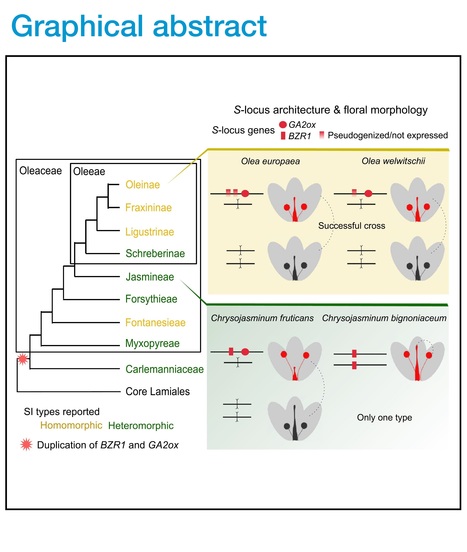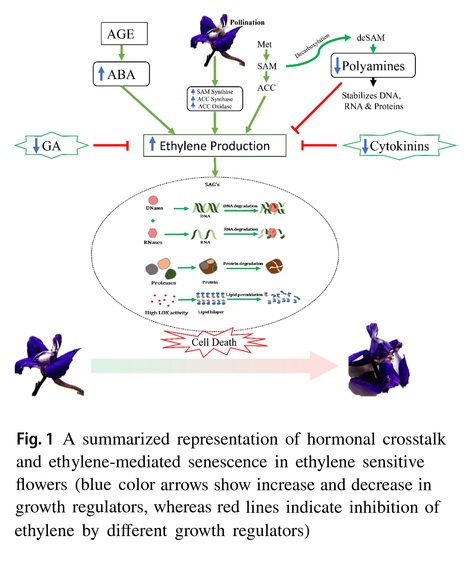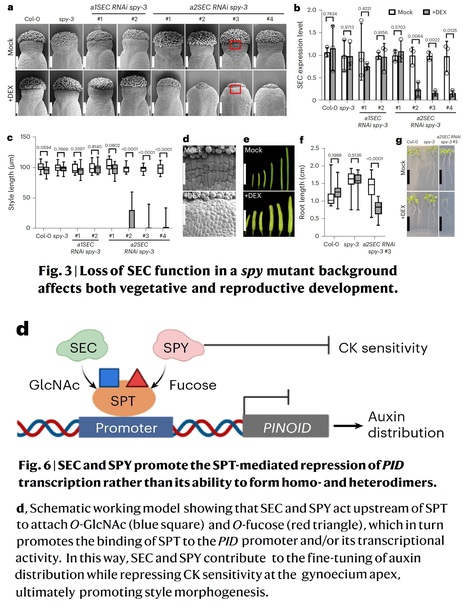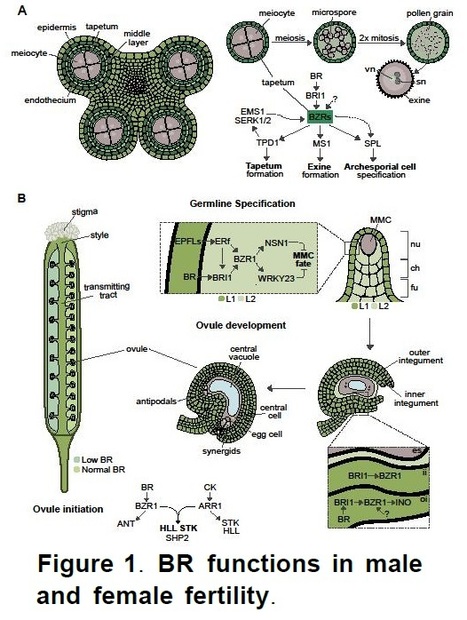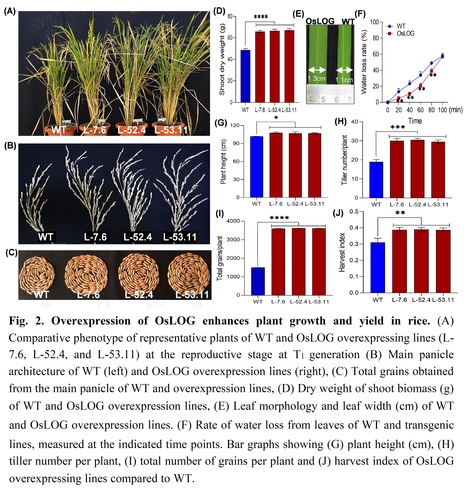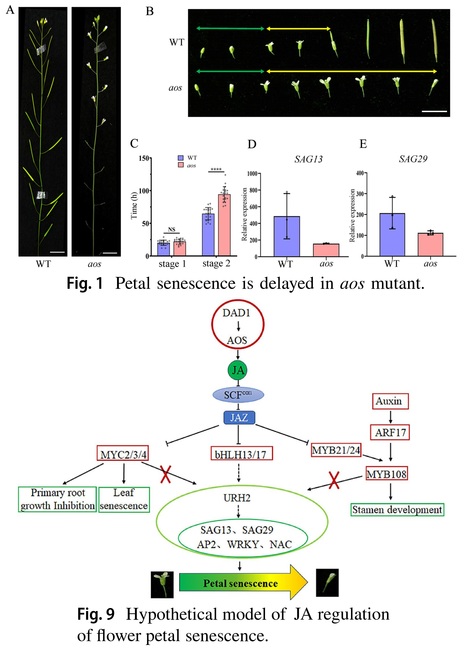 Your new post is loading...
 Your new post is loading...
Authors: Kumi Matsuura-Tokita, Takamasa Suzuki, Yusuke Kimata, Yumiko Takebayashi, Minako Ueda, Takeshi Nakano, Hitoshi Sakakibara, Akihiko Nakano, and Tetsuya Higashiyama.
bioRxiv (2024)
Abstract: "Brassinosteroids (BRs) are steroid hormones identified in plants. Besides promoting cell elongation and division, BRs facilitate the development of both male and female reproductive tissues. In animals, reproductive steroid hormones play an essential role in reproductive tissue development by regulating gene expression. Here, we focused on the function of BRs during fertilization. We measured the content of biologically active BRs, brassinolide (BL) and castasterone (CS), in the reproductive tissues of Arabidopsis thaliana. Both BL and CS accumulated abundantly in pollen grains and in larger amounts in pistils than in leaves. To evaluate BL function during fertilization, we used an in vitro guidance assay with exogenously applied BL. Although pollen tubes need to be elongated through the pistils for efficient capacitation, BL treatment promoted pollen tube capacitation and improved attraction to ovules in vitro. Transcriptome analysis demonstrated that BL treatment induced the expression of half of the genes expressed in pollen tubes that elongated through the pistils. These results indicated that BL supplied from pistils is a key factor for pollen tube capacitation. However, using the bri1 mutant for the guidance assay resulted in reduced pollen tube capacitation, suggesting that BRI1-signaling in pistils is also important. Furthermore, BRs act on ovules. Exogenous BL application to ovules maintained guidance capacity by promoting the expression of small secreted proteins involved in pollen tube attraction and gamete fusion. Overall, BRs play a significant role as male and female reproductive hormones throughout the plant fertilization process."
Authors: Hideki Yoshida and Makoto Matsuoka.
Molecular Plant (2024)
Excerpts: "For example, brassinosteroids (BRs) positively affect plant growth and grain size but negatively regulate the grain number and plant density (Figure 1, top left; Deveshwar et al., 2020; Hwang et al., 2021). Therefore, a thorough understanding of the trade-off functions and regulatory mechanisms of phytohormones is a promising avenue for agricultural improvement."
"Zhang et al. (2024) revealed the molecular regulation of panicle branching by BRs through the cloning and functional analysis of a long-puzzling gene for the clustered spikelet (CL) phenotype. These observations demonstrated that the proper regulation of BR function resulted in higher rice yield."
"Zhang et al. (2024) successfully cloned a causal gene for CL using an elegant genomic analysis with both short- and long-read sequencing techniques. The CL trait is associated with complex structural variations in chromosomes that activate the expression of the BR catabolic gene BRASSINOSTEROID-DEFICIENT DWARF3 (BRD3) in secondary branch meristems."
"Zhang et al. (2024) also showed that introducing the genetic modification of the BRD3 promoter into modern rice varieties resulted in a higher rice yield with a high grain number due to CL and no other defects in field tests."
Authors: Verónica Sánchez-Gerschon, Irene Martínez-Fernández, María R. González-Bermúdez, Sergio de la Hoz-Rodríguez, Florenci V. González, Jorge Lozano-Juste, Cristina Ferrándiz and Vicente Balanzà.
Plant Physiology (2024)
One-sentence summary: Three homeodomain leucine zipper transcription factors trigger abscisic acid accumulation in the inflorescence apex at the end of the reproductive phase, arresting unpollinated floral bud development.
Abstract: "Flowers, and hence, fruits and seeds, are produced by the activity of the inflorescence meristem after the floral transition. In plants with indeterminate inflorescences the final number of flowers produced by the inflorescence meristem is determined by the length of the flowering period, which ends with inflorescence arrest. Inflorescence arrest depends on many different factors, such as the presence of seeds, the influence of the environment, or endogenous factors such as phytohormone levels and age, which modulate inflorescence meristem activity. The FRUITFULL-APETALA2 (FUL-AP2) pathway plays a major role in regulating the end of flowering, likely integrating both endogenous cues and those related to seed formation. Among AP2 targets, HOMEOBOX PROTEIN21 (HB21) has been identified as a putative mediator of AP2 function in the control of inflorescence arrest. HB21 is a homeodomain leucine zipper transcription factor involved in establishing axillary bud dormancy. Here we characterized the role of HB21 in the control of the inflorescence arrest at the end of flowering in Arabidopsis (Arabidopsis thaliana). HB21, together with HB40 and HB53, are upregulated in the inflorescence apex at the end of flowering, promoting floral bud arrest. We also show that abscisic acid (ABA) accumulation occurs in the inflorescence apex in an HB-dependent manner. Our work suggests a physiological role of ABA in floral bud arrest at the end of flowering, pointing to ABA as a regulator of inflorescence arrest downstream of the HB21/40/53 genes."
Authors: Pauline Raimondeau, Sayam Ksouda, William Marande, Anne-Laure Fuchs, Hervé Gryta, Anthony Theron, Aurore Puyoou, Julia Dupin, Pierre-Olivier Cheptou, Sonia Vautrin, Sophie Valière, Sophie Manzi, Djamel Baali-Cherif, Jérôme Chave, Pascal-Antoine Christin and Guillaume Besnard.
Current Biology (2024)
Editor's view: Raimondeau et al. unveil the genetic determinants of the unique self-incompatibility system of olives. This initial discovery leads them to identify the genetic controls of distyly within the family and to uncover a genetic overlap between the two systems, rooted in shared ancestry.
Highlights: • Homomorphic self-incompatibility in olives is associated with a hemizygous region • A homologous hemizygous region is also involved in controlling distyly in jasmine • The duplication of this DNA segment is ancestral in the family • Hormonal regulation is central to the production of self-incompatibility phenotypes
Abstract: "Self-incompatibility (SI) has evolved independently multiple times and prevents self-fertilization in hermaphrodite angiosperms. Several groups of Oleaceae such as jasmines exhibit distylous flowers, with two compatibility groups each associated with a specific floral morph.1 Other Oleaceae species in the olive tribe have two compatibility groups without associated morphological variation.2,3,4,5 The genetic basis of both homomorphic and dimorphic SI systems in Oleaceae is unknown. By comparing genomic sequences of three olive subspecies (Olea europaea) belonging to the two compatibility groups, we first locate the genetic determinants of SI within a 700-kb hemizygous region present only in one compatibility group. We then demonstrate that the homologous hemizygous region also controls distyly in jasmine. Phylogenetic analyses support a common origin of both systems, following a segmental genomic duplication in a common ancestor. Examination of the gene content of the hemizygous region in different jasmine and olive species suggests that the mechanisms determining compatibility groups and floral phenotypes (whether homomorphic or dimorphic) in Oleaceae rely on the presence/absence of two genes involved in gibberellin and brassinosteroid regulation."
Authors: Nguyen Hoai Nguyen, Phuong Thi Bich Ho and Linh Thi Truc Le.
Plant Reproduction (2024)
Key message: This review provides a thorough and comprehensive perspective on the topic of cucumber sexual expression. Specifically, insights into sex expression mediated by pathways other than ethylene are highlighted.
Abstract: "Cucumber (Cucumis sativus L.) is a common and important commercial crop that is cultivated and consumed worldwide. Additionally, this species is commonly used as a model for investigating plant sex expression. Cucumbers exhibit a variety of floral arrangements, comprising male, female, and hermaphroditic (bisexual) flowers. Generally, cucumber plants that produce female flowers are typically preferred due to their significant impact on the overall output. Various environmental conditions, such as temperature, light quality, and photoperiod, have been also shown to influence the sex expression in this species. Multiple lines of evidence indicate that ethylene and its biosynthesis genes are crucial in regulating cucumber sex expression. Gibberellins, another well-known phytohormone, can similarly influence cucumber sex expression via an ethylene-independent route. Further studies employing the next-generation sequencing technology also visualized a deeper slice of the molecular mechanism such as the role of the cell cycle program in the cucumber sex expression. This review aims to provide an overview of the sex expression of cucumber including its underlying molecular mechanism and regulatory aspects based on recent investigations."
Authors: Jian Che, Xu Li and Yidan Ouyang.
Plant Communications (2024)
Excerpts: "The use of strong heterosis from indica-japonica hybrid rice could greatly increase yield potential in the future. Nevertheless, due to their long-term adaptation to different environments, indica and japonica rice varieties have evolved distinct phenotypic variations from growth to flowering. This leads to the existence of multiple reproductive barriers between the two subspecies. Consequently, prezygotic reproductive isolation caused by differentiated DFOTs and postzygotic reproductive isolation, such as hybrid sterility, which occurs in intersubspecific crosses, hinder the exploitation of indica-japonica hybrid rice (Figure 1)."
"Another possible approach for optimizing non-overlapping DFOTs might be the spraying of exogenous plant hormones (Wang et al., 2023). For example, spraying methyl jasmonate (MeJA) shows extensive applicability in regulating DFOT. In fact, OsMYB8 can regulate floret opening by inducing the accumulation of endogenous JA-Ile in lodicules. Latest research also confirmed the significance of JA in floret opening process, as overexpressing the JA biosynthesis gene OsOPR7 and knocking out the JA inactivation gene OsHAN1 can effectively promote the DFOT of japonica rice (Wang et al., 2024). Advanced DFOT can also be achieved by knockout of the JA signal suppressor genes OsJAZ7 and OsJAZ9. Other hormones, such as auxins and gibberellins, may also be involved in DFOT regulation and have the potential to improve DFOT."
Authors: Shannon A. Stirling, Angelica M. Guercio, Ryan M. Patrick, Xing-Qi Huang, Matthew E. Bergman, Varun Dwivedi, Ruy W. J. Kortbeek, Yi-Kai Liu, Fuai Sun, W. Andy Tao, Ying Li, Benoît Boachon, Nitzan Shabek and Natalia Dudareva.
Science (2024)
One-sentence summary: Informational exchange in plants occurs stereospecifically via volatile terpenoids and the KAI2-like signaling pathway.
Editor’s view: Plant responses to chemical signals carried through the air are critical for development, fitness, and adaptation. Stirling et al. identified a mechanism for the perception of the volatile compound (−)-germacrene D through a homolog of the Karrikin receptor KAI2 in petunia pistils. Genetic and biochemical experiments linked this perception with downstream signaling proteins and transcriptional targets. Perturbing the function of some of these components affected volatile-mediated communication and plant fitness.
Abstract: "Plants are constantly exposed to volatile organic compounds (VOCs) that are released during plant-plant communication, within-plant self-signaling, and plant-microbe interactions. Therefore, understanding VOC perception and downstream signaling is vital for unraveling the mechanisms behind information exchange in plants, which remain largely unexplored. Using the hormone-like function of volatile terpenoids in reproductive organ development as a system with a visual marker for communication, we demonstrate that a petunia karrikin-insensitive receptor, PhKAI2ia, stereospecifically perceives the (−)-germacrene D signal, triggering a KAI2-mediated signaling cascade and affecting plant fitness. This study uncovers the role(s) of the intermediate clade of KAI2 receptors, illuminates the involvement of a KAI2ia-dependent signaling pathway in volatile communication, and provides new insights into plant olfaction and the long-standing question about the nature of potential endogenous KAI2 ligand(s)."
Authors: Yu-Lan Zhang, Li-Ying Wang, Yi Yang, Xu Zhao, Hong-Wei Zhu, Chen You, Ning Chen, Shuai-Jie Wei, Shu-Fen Li and Wu-Jun Gao.
The Plant Journal (2024)
Significance Statement: Using environmental factors such as hormones to induce sex conversion is an important approach to studying dioecy sex differentiation, which is a special character closely related to flowering, reproduction, and fruiting. In our research, exogenous GA3 can induce functional masculinization of individual spinach, and the GA-regulating pathway was established: GA-SpGAI-SpSTM-SpPI. This study provides new ideas and theoretical support for studying the sex differentiation mechanisms of spinach and other dioecious plants.
Abstract: "The sex of dioecious plants is mainly determined by genetic factors, but it can also be converted by environmental cues such as exogenous phytohormones. Gibberellic acids (GAs) are well-known inducers of flowering and sexual development, yet the pathway of gibberellin-induced sex conversion in dioecious spinach (Spinacia oleracea L.) remains elusive. Based on sex detection before and after GA3 application using T11A and SSR19 molecular markers, we confirmed and elevated the masculinization effect of GA on a single female plant through exogenous applications of GA3, showing complete conversion and functional stamens. Silencing of GIBBERELLIC ACID INSENSITIVE (SpGAI), a single DELLA family protein that is a central GA signaling repressor, results in similar masculinization. We also show that SpGAI can physically interact with the spinach KNOX transcription factor SHOOT MERISTEMLESS (SpSTM), which is a homolog of the flower meristem identity regulator STM in Arabidopsis. The silencing of SpSTM also masculinized female flowers in spinach. Furthermore, SpSTM could directly bind the intron of SpPI to repress SpPI expression in developing female flowers. Overall, our results suggest that GA induces a female masculinization process through the SpGAI-SpSTM-SpPI regulatory module in spinach. These insights may help to clarify the molecular mechanism underlying the sex conversion system in dioecious plants while also elucidating the physiological basis for the generation of unisexual flowers so as to establish dioecy in plants."
Authors: Enyang Mei, Mingliang He, Min Xu, Jiaqi Tang, Jiali Liu, Yingxiang Liu, Zhipeng Hong, Xiufeng Li, Zhenyu Wang, Qingjie Guan, Xiaojie Tian and Qingyun Bu.
Journal of Integrative Plant Biology (2024)
Abstract: "Panicle exsertion is one of the crucial agronomic traits in rice (Oryza sativa). Shortening of panicle exsertion often leads to panicle enclosure and severely reduces seed production. Gibberellin (GA) plays important roles in regulating panicle exsertion. However, the underlying mechanism and the relative regulatory network remain elusive. Here, we characterized the oswrky78 mutant showing severe panicle enclosure, and found that the defect of oswrky78 is caused by decreased bioactive GA contents. Biochemical analysis demonstrates that OsWRKY78 can directly activate GA biosynthesis and indirectly suppress GA metabolism. Moreover, we found OsWRKY78 can interact with and be phosphorylated by mitogen-activated protein kinase (MAPK) kinase OsMAPK6, and this phosphorylation can enhance OsWRKY78 stability and is necessary for its biological function. Taken together, these results not only reveal the critical function of OsWRKY78, but also reveal its mechanism via mediating crosstalk between MAPK and the GA signaling pathway in regulating panicle exsertion."
Authors: Aehsan ul Haq, Sumira Farooq, Mohammad Lateef Lone, Shazia Parveen, Foziya Altaf and Inayatullah Tahir
Journal of Plant Growth Regulation (2024)
Abstract: "Postharvest senescence of cut flowers is a stumbling impediment in harnessing their commercial potential. Consequently, the postharvest quality preservation of cut flowers is a crucial factor to allure buyers and maximize economic gains. Flower senescence being final phase of organ development is a key factor triggering postharvest quality deterioration. The process of flower senescence is closely regulated by developmental and environmental cues. The perception of these signals subsequently involves loss of membrane integrity, decreased activity of antioxidant enzymes, and upregulation of proteases and nucleases, which are key signatures of senescence and culminate in the death of petal tissues. Moreover, the developmental and environmental cues are synchronized by considerable turnover in different growth regulators, particularly cytokinins, abscisic acid, ethylene, and gibberellic acid, which act both antagonistically and synergistically to coordinate the senescence process in flowers. Among these growth regulators, ethylene has a crucial role in orchestrating petal senescence in ethylene-responsive systems, while, abscisic acid regulates petal senescence in ethylene-independent systems. Recent research on ethylene-sensitive flowers revealed that the crosstalk of ethylene with sugars and other growth regulators plays a crucial role in modulating senescence by affecting the expression of ethylene-responsive genes. Despite the plethora of postharvest studies conducted so far, considerable miss links still persist in understanding the intricacies of senescence regulating mechanisms, mainly in ethylene-responsive flowers. To this end, it is imperative to critically re-evaluate our current understanding of ethylene-dependent flower senescence to gain intricate inputs regarding the underlying senescence mechanisms, particularly in ornamental families like Ranunculaceae. This constitutes the pivotal gateway toward deciphering the enigmatic complexities governing senescence regulatory mechanisms, thereby forging a path for postharvest researchers to craft pioneering methodologies aimed at accentuating the longevity of commercially significant flowers, thereby yielding substantial economic ramifications."
Authors: Jingyun Lu, Guifang Zhang, Chao Ma, Yao Li, Chuyan Jiang, Yaru Wang, Bingjie Zhang, Rui Wang, Yuexuan Qiu, Yanxing Ma, Yangchao Jia, Cai-Zhong Jiang, Xiaoming Sun, Nan Ma, Yunhe Jiang and Junping Gao.
The Plant Cell (2024)
One-sentence summary: An ethylene-induced F-box protein, RhSAF, accelerates petal senescence by destabilizing the gibberellic acid receptor RhGID1.
Abstract: "Roses are among the most popular ornamental plants cultivated worldwide for their great economic, symbolic, and cultural importance. Nevertheless, rapid petal senescence markedly reduces rose (Rosa hybrida) flower quality and value. Petal senescence is a developmental process tightly regulated by various phytohormones. Ethylene accelerates petal senescence, while gibberellic acid (GA) delays this process. However, the molecular mechanisms underlying the crosstalk between these phytohormones in the regulation of petal senescence remain largely unclear. Here, we identified SENESCENCE-ASSOCIATED F-BOX (RhSAF), an ethylene-induced F-box protein gene encoding a recognition subunit of the SCF-type E3 ligase. We demonstrated that RhSAF promotes degradation of the GA receptor GIBBERELLIN INSENSITIVE DWARF1 (RhGID1) to accelerate petal senescence. Silencing RhSAF expression delays petal senescence, while suppressing RhGID1 expression accelerates petal senescence. RhSAF physically interacts with RhGID1s and targets them for ubiquitin/26S proteasome-mediated degradation. Accordingly, ethylene-induced RhGID1C degradation and RhDELLA3 accumulation are compromised in RhSAF-RNAi lines. Our results demonstrate that ethylene antagonizes GA activity through RhGID1 degradation mediated by the E3 ligase RhSAF. These findings enhance our understanding of the phytohormone crosstalk regulating petal senescence and provide insights for improving flower longevity."
Authors: Yuki Furuta, Haruka Yamamoto, Takeshi Hirakawa, Akira Uemura, Margaret Anne Pelayo, Hideaki Iimura, Naoya Katagiri, Noriko Takeda-Kamiya, Kie Kumaishi, Makoto Shirakawa, Sumie Ishiguro, Yasunori Ichihashi, Takamasa Suzuki, Tatsuaki Goh, Kiminori Toyooka, Toshiro Ito & Nobutoshi Yamaguchi
Nature Communications (2024)
Editor's view: In angiosperms, petal abscission is crucial for reproductive success and seed dispersion. However, the regulation of this abscission remains unclear. Here, the authors identify a process of petal abscission regulated by jasmonic acid via autophagy at the base of Arabidopsis petals.
Abstract: "In angiosperms, the transition from floral-organ maintenance to abscission determines reproductive success and seed dispersion. For petal abscission, cell-fate decisions specifically at the petal-cell base are more important than organ-level senescence or cell death in petals. However, how this transition is regulated remains unclear. Here, we identify a jasmonic acid (JA)-regulated chromatin-state switch at the base of Arabidopsis petals that directs local cell-fate determination via autophagy. During petal maintenance, co-repressors of JA signaling accumulate at the base of petals to block MYC activity, leading to lower levels of ROS. JA acts as an airborne signaling molecule transmitted from stamens to petals, accumulating primarily in petal bases to trigger chromatin remodeling. This allows MYC transcription factors to promote chromatin accessibility for downstream targets, including NAC DOMAIN-CONTAINING PROTEIN102 (ANAC102). ANAC102 accumulates specifically at the petal base prior to abscission and triggers ROS accumulation and cell death via AUTOPHAGY-RELATED GENEs induction. Developmentally induced autophagy at the petal base causes maturation, vacuolar delivery, and breakdown of autophagosomes for terminal cell differentiation. Dynamic changes in vesicles and cytoplasmic components in the vacuole occur in many plants, suggesting JA–NAC-mediated local cell-fate determination by autophagy may be conserved in angiosperms."
Authors: Yuxiang Jiang, Seamus Curran-French, Samuel W. H. Koh, Iqra Jamil, Benguo Gu, Luca Argirò, Sergio G. Lopez, Carlo Martins, Gerhard Saalbach and Laila Moubayidin.
Nature Plants (2024)
Editor's view: The Arabidopsis O-glycosyltransferases SEC and SPY modify the transcription factor SPT and synergistically promote style elongation. Specific SPT residues modified by O-GlcNAc and O-fucose are essential for style radialization.
Abstract: "O-linked β-N-acetylglucosamine (O-GlcNAc) and O-fucose are two sugar-based post-translational modifications whose mechanistic role in plant signalling and transcriptional regulation is still largely unknown. Here we investigated how two O-glycosyltransferase enzymes of Arabidopsis thaliana, SPINDLY (SPY) and SECRET AGENT (SEC), promote the activity of the basic helix–loop–helix transcription factor SPATULA (SPT) during morphogenesis of the plant female reproductive organ apex, the style. SPY and SEC modify amino-terminal residues of SPT in vivo and in vitro by attaching O-fucose and O-GlcNAc, respectively. This post-translational regulation does not impact SPT homo- and heterodimerization events, although it enhances the affinity of SPT for the kinase PINOID gene locus and its transcriptional repression. Our findings offer a mechanistic example of the effect of O-GlcNAc and O-fucose on the activity of a plant transcription factor and reveal previously unrecognized roles for SEC and SPY in orchestrating style elongation and shape."
|
Authors: Kun Dong, Fuqing Wu, Siqi Cheng, Shuai Li, Feng Zhang, Xinxin Xing, Xin Jin, Sheng Luo, Miao Feng, Rong Miao, Yanqi Chang, Shuang Zhang, Xiaoman You, Peiran Wang, Xin Zhang, Cailin Lei, Yulong Ren, Shanshan Zhu, Xiuping Guo, Chuanyin Wu, Dong-Lei Yang, Qibing Lin, Zhijun Cheng and Jianmin Wan.
Molecular Plant (2024)
Abstract: "Although both protein arginine methylation (PRMT) and jasmonate (JA) signaling are crucial for regulating plant development, the relationship between these processes in spikelet development control remains unclear. Here, we utilized CRISPR/Cas9 technology to generate two OsPRMT6a loss-of-function mutants exhibiting various abnormal spikelet structures. Additionally, we found that OsPRMT6a could methylate arginine residues in the JA signal repressors OsJAZ1 and OsJAZ7. Arginine methylation of OsJAZ1 increased the affinity of OsJAZ1 for the JA receptors OsCOI1a and OsCOI1b in the presence of jasmonates (JAs), subsequently promoting the ubiquitination of OsJAZ1 by the SCFOsCOI1a/OsCOI1b complex and degradation via the 26S proteasome. This process ultimately released OsMYC2, a core transcriptional regulator in the JA signaling pathway, to activate or repress JA-responsive genes, thereby maintaining normal plant (spikelet) development. However, in the osprmt6a-1 mutant, reduced arginine methylation of OsJAZ1 impaired the interaction between OsJAZ1 and OsCOI1a/OsCOI1b in the presence of JAs. As a result, OsJAZ1 proteins became more stable, repressing JA responses, thus causing the formation of abnormal spikelet structures. Moreover, we discovered that JA signaling reduced the OsPRMT6a mRNA level in an OsMYC2-dependent manner, thereby establishing a negative feedback loop to balance JA signaling. Furthermore, we found that OsPRMT6a-mediated arginine methylation of OsJAZ1 likely serves as a switch to tune JA signaling to maintain normal spikelet development under harsh environmental conditions such as high temperatures. Thus, our study established a direct molecular link between arginine methylation and the JA signaling pathway.
Authors: R. B. Lima and D. D. Figueiredo.
Plant and Cell Physiology (2024)
Abstract: "Since the discovery of brassinolide in the pollen of rapeseed, brassinosteroids (BRs) have consistently been associated with reproductive traits. However, compared to what is known for how BRs shape vegetative development, the understanding of how these hormones regulate reproductive traits is comparatively still lacking. Nevertheless, there is now considerable evidence that BRs regulate almost all aspects of reproduction, from ovule and pollen formation to seed and fruit development. Here, we review the current body of knowledge on how BRs regulate reproductive processes in plants, and what is known about how these pathways are transduced at the molecular level. We then discuss how the manipulation of BR biosynthesis and signaling can be a promising avenue for improving crop traits which rely on efficient reproduction. We thus propose that BR hold an untapped potential for plant breeding, which could contribute to attain food security in the coming years."
Authors: Ray Singh Rathore, Manjari Mishra, Ashwani Pareek and Sneh Lata Singla-Pareek.
Plant Physiology and Biochemistry (2024)
Highlights: • Overexpression of Lonely Guy (OsLOG) gene in rice leads to increase in the active form (trans-zeatin) of cytokinin. • OsLOG mediated elevated cytokinin levels promote ideal plant architecture and rice yield. • Elevated cytokinin levels in OsLOG transgenic lines enhance tolerance to drought and salinity stress and reduce yield penalty through maintenance of redox homeostasis.
Abstract: "Meristem activity is important for normal plant growth as well as adaptive plastic development under abiotic stresses. Cytokinin has been recognized to have a major role in regulating meristem function which is controlled by cytokinin activating enzymes by fine-tuning the concentrations and spatial distribution of its bioactive forms. It was previously reported that LONELY GUY (LOG) acts in the direct activation pathway of cytokinin in rice shoot meristems. LOG has a cytokinin specific phosphoribohydrolase activity, which transforms inactive cytokinin nucleotides into active free bases. Here, we explored the role of OsLOG in controlling meristem activity mediated by cytokinin and its effects on growth, development, and stress resilience of rice plants. Overexpression of OsLOG in rice led to significant alterations in cytokinin levels in the inflorescence meristem, leading to enhanced plant growth, biomass and grain yield under both non-stress as well as stress conditions such as drought and salinity. Moreover, our study provides insight into how overexpression of OsLOG improves the ability of plants to withstand stress. The OsLOG-overexpressing lines exhibit reduced accumulation of H2O2 along with elevated antioxidant enzyme activities, thereby maintaining better redox homeostasis under stress conditions. This ultimately reduces the negative impact of stresses on grain yield and improves harvest index, as evidenced by observations in the OsLOG-overexpressing lines. In summary, our study emphasizes the diverse role of OsLOG, not only in regulating plant growth and yield via cytokinin but also in enhancing adaptability to abiotic stresses. This highlights its potential to improve crop yield and promote sustainable agriculture."
Authors: Vincent Castric, Rita A. Batista, Amélie Carré, Soraya Mousavi, Clément Mazoyer, Cécile Godé, Sophie Gallina, Chloé Ponitzki, Anthony Theron, Arnaud Bellec, William Marande, Sylvain Santoni, Roberto Mariotti, Andrea Rubini, Sylvain Legrand, Sylvain Billiard, Xavier Vekemans, Philippe Vernet and Pierre Saumitou-Laprade.
Current Biology (2024)
Editor's view: The self-incompatibility system of the Oleaceae is unusual, with the long-term maintenance of only two groups of reproductive compatibility. Castric et al. identify a hemizygous chromosomal fragment unique to one specificity, containing a single conserved gene with predicted function in catabolism of gibberellin.
Highlights: • The segregation of a genome fragment controls self-incompatibility (SI) in Oleaceae • This is the first report of hemizygous control of a homomorphic SI system • This fragment contains a single conserved gene, related to the gibberellin pathway • Manipulation of gibberellin levels switches self-incompatibility specificities
Abstract; "In flowering plants, outcrossing is commonly ensured by self-incompatibility (SI) systems. These can be homomorphic (typically with many different allelic specificities) or can accompany flower heteromorphism (mostly with just two specificities and corresponding floral types). The SI system of the Oleaceae family is unusual, with the long-term maintenance of only two specificities but often without flower morphology differences. To elucidate the genomic architecture and molecular basis of this SI system, we obtained chromosome-scale genome assemblies of Phillyrea angustifolia individuals and related them to a genetic map. The S-locus region proved to have a segregating 543-kb indel unique to one specificity, suggesting a hemizygous region, as observed in all distylous systems so far studied at the genomic level. Only one of the predicted genes in this indel region is found in the olive tree, Olea europaea, genome, also within a segregating indel. We describe complete association between the presence/absence of this gene and the SI types determined for individuals of seven distantly related Oleaceae species. This gene is predicted to be involved in catabolism of the gibberellic acid (GA) hormone, and experimental manipulation of GA levels in developing buds modified the male and female SI responses of the two specificities in different ways. Our results provide a unique example of a homomorphic SI system, where a single conserved gibberellin-related gene in a hemizygous indel underlies the long-term maintenance of two groups of reproductive compatibility."
Authors: Yajun Gou, Yueqin Heng, Wenyan Ding, Canhong Xu, Qiushuang Tan, Yajing Li, Yudong Fang, Xiaoqing Li, Degui Zhou, Xinyu Zhu, Mingyue Zhang, Rongjian Ye, Haiyang Wang and Rongxin Shen.
Nature Communications (2024)
Editor's view: Florets of indica rice open earlier than japonica rice, hindering utilization of the cross subspecies heterosis. Here, the authors show that an OsMYB8-OsJAR1 module regulates diurnal floret opening time divergences between the two subspecies.
Abstract: "The inter-subspecific indica-japonica hybrid rice confer potential higher yield than the widely used indica-indica intra-subspecific hybrid rice. Nevertheless, the utilization of this strong heterosis is currently hindered by asynchronous diurnal floret opening time (DFOT) of indica and japonica parental lines. Here, we identify OsMYB8 as a key regulator of rice DFOT. OsMYB8 induces the transcription of JA-Ile synthetase OsJAR1, thereby regulating the expression of genes related to cell osmolality and cell wall remodeling in lodicules to promote floret opening. Natural variations of OsMYB8 promoter contribute to its differential expression, thus differential transcription of OsJAR1 and accumulation of JA-Ile in lodicules of indica and japonica subspecies. Furthermore, introgression of the indica haplotype of OsMYB8 into japonica effectively promotes DFOT in japonica. Our findings reveal an OsMYB8-OsJAR1 module that regulates differential DFOT in indica and japonica, and provide a strategy for breeding early DFOT japonica to facilitate breeding of indica-japonica hybrids."
Authors: Jing Chen, Senlin Jiang, Guobin Yang, Lujun Li, Jing Li and Fengjuan Yang.
Plant Physiology and Biochemistry (2024)
Highlights: • SmMYB113 can increase flower drop rate in eggplant. • SmMYB113 regulates ethylene-dependent flower abscission by directly activating the ethylene biosynthetic genes. • SmERF38 enhanced the activation of SmMYB113 on the promoters of SmACS1 by interaction.
Abstract: "Flower abscission is an important developmental process that can significantly reduce the yield of horticultural plants. We previously reported that SmMYB113 is a key transcription factor promoting anthocyanin biosynthesis and improve fruit quality. However, the overexpression of SmMYB113 in eggplant increased flower drop rate and reduced fruit yield. Here, we elucidate the regulatory mechanisms of SmMYB113 on flower abscission in eggplant. RNA-seq analysis indicated that the regulation of flower abscission by SmMYB113 was associated with altered expression of genes related to ethylene biosynthesis and signal transduction, including ethylene biosynthetic genes SmACS1, SmACS8 and SmACO4. Then, the ethylene content in flowers and the function of ethephon (ETH, which promotes fruit ripening) and 1-Methylcyclopropene (1-MCP, which acts as an ethylene perception inhibitor) were analyzed, which revealed that SmMYB113 directly regulates ethylene-dependent flower abscission. Yeast one-hybrid and dual-luciferase assays revealed that SmMYB113 could directly bind to the promoters of SmACS1, SmACS8, and SmACO4 to activate their expression. Through construction of a yeast two-hybrid (Y2H) screening library, the protein SmERF38 was found to interact with SmMYB113, and verified by Y2H, bimolecular fluorescence complementation (BiFC), and luciferase complementation assay. Furthermore, dual-luciferase assays showed that SmERF38 enhanced the role of SmMYB113 on the promoters of SmACS1. Our results provided new insight into the molecular mechanism of flower abscission in eggplant."
Authors: Mingli Liao, Zhenyong Chen, Yichao Wu, Qian Yang, Jian Zou, Zhengsong Peng, Yuhao Li, Wenxuan Liu, Zaijun Yang and Yonghong Zhou.
Journal of Plant Growth Regulation (2024)
Abstract: "Previous studies have shown that ethylene levels in flower buds are key to sex determination in plants. However, the roles of ethylene in wheat flower development are poorly understood. In this study, pistillody wheat HTS-1 (three-pistil trait), CM28TP (three-pistil trait), CS (one-pistil trait), and CM28 (one-pistil trait) were used as experimental materials. The effect of exogenous ethephon (ETH) and 1-methylcyclopropene (1-MCP) on the morphology of wheat flowers and candidate genes in the ethylene signaling pathway was investigated. The results revealed that exogenous ETH or 1-MCP treatment had a strong effect on the stamens but not on the pistils of wheat. Specifically, after treatment with ETH, the stamens of CS and CM28 became significantly shorter, while in CM28TP, 71.38% of stamens were homologously transformed into pistils or pistil-like structures (pistillody). Moreover, after treatment with 1-MCP, the pistillody stamens of HTS-1 were transformed back into stamens, and the pistillody rate decreased from 73.61 to 55.25%. Furthermore, pistillody occurred in three-pistil wheat but not in one-pistil wheat, so the three-pistil trait was closely related to the occurrence of pistillody. In addition, the expression of the ethylene transduction genes TaETR1, TaCTR1, and TaEIN2 and the ethylene response gene TaERF was upregulated under pistillody. Among them, TaCTR1 presented the highest level under pistillody, being 150 times in HTS-1 and 103 times higher in CM28TP treated with ETH than in CM28TP. Moreover, the ERELEE4 cis-acting element was found upstream of the TaCTR1 gene promoter and could facilitate homologous transformation of stamens into pistils or pistil-like structures. The results lay a theoretical foundation for analyzing the effect of ethylene on wheat flower development and supply important information for wheat hybrid breeding."
Authors: Liuqing Wu, Kaiqi Wang, Mengyi Chen, Wenxin Su, Zheng Liu, Xiaoying Guo, Mengqian Ma, Shuangjie Qian, Yuqi Deng, Haihan Wang, Chanjuan Mao, Zaibao Zhang and Xiaofeng Xu.
Physiology and Molecular Biology of Plants (2024)
Abstract: "Flowers are crucial for the reproduction of flowering plants and their senescence has drastic effects on plant-animal interactions as well as pollination. Petal senescence is the final phase of flower development which is regulated by hormones and genes. Among these, jasmonic acid (JA) has emerged as a major contributor to petal senescence, but its molecular mechanisms remain elusive. Here, the role of JA in petal senescence in Arabidopsis was investigated. We showed that petal senescence in aos mutant was significantly delayed, which also affected petal cell size and proliferation. Similar significant delays in petal senescence were observed in dad1 and coi1 mutants. However, MYB21/24 and MYC2/3/4, known downstream regulators of JA in flower development, played no role in petal senescence. This indicated that JA regulates petal senescence by modulating other unknown transcription factors. Transcriptomic analysis revealed that AOS altered the expression of 3681 genes associated, and identified groups of differentially expressed transcription factors, highlighting the potential involvement of AP-2, WRKY and NAC. Furthermore, bHLH13, bHLH17 and URH2 were identified as potential new regulators of JA-mediated petal senescence. In conclusion, our findings suggest a novel genetic pathway through which JA regulates petal senescence in Arabidopsis. This pathway operates independently of stamen development and leaf senescence, suggesting the evolution of specialized mechanisms for petal senescence."
Authors: Xiaoxing Zhang, Wenjing Meng, Dapu Liu, Dezhuo Pan, Yanzhao Yang, Zhuo Chen, Xiaoding Ma, Wenchao Yin, Mei Niu, Nana Dong, Jihong Liu, Weifeng Shen, Yuqin Liu, Zefu Lu, Chengcai Chu, Qian Qian, Mingfu Zhao and Hongning Tong.
Science (2024)
One-sentence summary: Cell-specific activation of a brassinosteroid-degrading enzyme results in clustered-spikelet rice and improves grain yield.
Editor's view: Hormones are small mobile signaling molecules that control growth and development. Zhang et al. studied how a hormone signaling pathway acts in a precise spatiotemporal manner (i.e., cell- and tissue-specific signaling) to enhance grain number in rice. They identified a brassinosteroid catabolism gene that is the causative gene underlying enhanced grain number in Clustered-Spikelet rice through a signaling cascade and downstream gene expression of a key transcription factor. This work paves the way to understanding how spatial regulation of brassinosteroid hormonal pathways in secondary branch meristems enhances panicle branching and grain number, crucial traits for enhancing rice yields.
Abstract: "Crop yield potential is constrained by the inherent trade-offs among traits such as between grain size and number. Brassinosteroids (BRs) promote grain size, yet their role in regulating grain number is unclear. By deciphering the clustered-spikelet rice germplasm, we show that activation of the BR catabolic gene BRASSINOSTEROID-DEFICIENT DWARF3 (BRD3) markedly increases grain number. We establish a molecular pathway in which the BR signaling inhibitor GSK3/SHAGGY-LIKE KINASE2 phosphorylates and stabilizes OsMADS1 transcriptional factor, which targets TERMINAL FLOWER1-like gene RICE CENTRORADIALIS2. The tissue-specific activation of BRD3 in the secondary branch meristems enhances panicle branching, minimizing negative effects on grain size, and improves grain yield. Our study showcases the power of tissue-specific hormonal manipulation in dismantling the trade-offs among various traits and thus unleashing crop yield potential in rice."
Authors: Leticia F. Ferigolo, Mateus H. Vicente, Joao P. O. Correa, Carlos H. Barrera-Rojas, Eder M. Silva, Geraldo F. F. Silva, Airton Carvalho Jr, Lazaro E. P. Peres, Guilherme B. Ambrosano, Gabriel R. A. Margarido, Robert Sablowski and Fabio T. S. Nogueira.
Development (2023)
Summary: Tomato floral meristem determinacy and fruit development are both orchestrated by the interplay between gibberellin and microRNA156-targeted SlSBP genes.
Abstract: "Many developmental processes associated with fruit development occur at the floral meristem (FM). Age-regulated microRNA156 (miR156) and gibberellins (GAs) interact to control flowering time, but their interplay in subsequent stages of reproductive development is poorly understood. Here, in tomato (Solanum lycopersicum), we show that GA and miR156-targeted SQUAMOSA PROMOTER-BINDING PROTEIN-LIKE (SPL or SBP) genes interact in the tomato FM and ovary patterning. High GA responses or overexpression of miR156 (156OE), which leads to low expression levels of miR156-silenced SBP genes, resulted in enlarged FMs, ovary indeterminacy and fruits with increased locule number. Conversely, low GA responses reduced indeterminacy and locule number, and overexpression of a S. lycopersicum (Sl)SBP15 allele that is miR156 resistant (rSBP15) reduced FM size and locule number. GA responses were partially required for the defects observed in 156OE and rSBP15 fruits. Transcriptome analysis and genetic interactions revealed shared and divergent functions of miR156-targeted SlSBP genes, PROCERA/DELLA and the classical WUSCHEL/CLAVATA pathway, which has been previously associated with meristem size and determinacy. Our findings reveal that the miR156/SlSBP/GA regulatory module is deployed differently depending on developmental stage and create novel opportunities to fine-tune aspects of fruit development that have been important for tomato domestication."
Authors: Yuxing Fang, Dongshu Guo, Yi Wang, Ning Wang, Xianwen Fang, Yunhui Zhang, Xiao Li, Letian Chen, Diqiu Yu, Baolong Zhang and Genji Qin.
The Plant Cell (2024)
One-sentence summary: A transcriptional repressor interacts with a transcription factor to modulate rice anther dehiscence and male sterility by finely regulating jasmonic acid biosynthesis during anther development.
Abstract: "Proper anther dehiscence is essential for successful pollination and reproduction in angiosperms, and jasmonic acid (JA) is crucial for the process. However, the mechanisms underlying tight regulation of JA biosynthesis during anther development remain largely unknown. Here, we demonstrate that the rice (Oryza sativa L.) ERF-associated amphiphilic repression (EAR) motif-containing protein TCP INTERACTOR CONTAINING EAR MOTIF PROTEIN1 (OsTIE1) tightly regulates JA biosynthesis by repressing TEOSINTE BRANCHED1/CYCLOIDEA/PROLIFERATING CELL FACTORS (TCP) transcription factor OsTCP1/PCF5 during anther development. The loss of OsTIE1 function in Ostie1 mutants causes male sterility. The Ostie1 mutants display inviable pollen, early stamen filament elongation and precocious anther dehiscence. In addition, JA biosynthesis is activated earlier and JA abundance is precociously increased in Ostie1 anthers. OsTIE1 is expressed during anther development, and OsTIE1 is localized in nuclei and has transcriptional repression activity. OsTIE1 directly interacts with OsTCP1, and overexpression of OsTCP1 caused early anther dehiscence resembling that of Ostie1. JA biosynthesis genes including rice LIPOXYGENASE (OsLOX) are regulated by the OsTIE1-OsTCP1 complex. Our findings reveal that the OsTIE1-OsTCP1 module plays a critical role in anther development by finely tuning JA biosynthesis and provide a foundation for the generation of male sterile plants for hybrid seed production."
Authors: Inger B. Holme, Christina R. Ingvardsen, Giuseppe Dionisio, Dagmara Podzimska-Sroka, Kell Kristiansen, Anders Feilberg and Henrik Brinch-Pedersen.
Plant Biotechnology Journal (2024)
Abstract: "Improving tolerance to ethylene-induced early senescence of flowers and fruits is of major economic importance for the ornamental and food industry. Genetic modifications of genes in the ethylene-signalling pathway have frequently resulted in increased tolerance but often with unwanted side effects. Here, we used CRISPR/Cas9 to knockout the function of two CpEil1 genes expressed in flowers of the diploid ornamental plant Campanula portenschlagiana. The ethylene tolerance in flowers of the primary mutants with knockout of only one or all four alleles clearly showed increased tolerance to exogenous ethylene, although lower tolerance was obtained with one compared to four mutated alleles. The allele dosage effect was confirmed in progenies where flowers of plants with zero, one, two, three and four mutated alleles showed increasing ethylene tolerance. Mutation of the Cpeil1 alleles had no significant effect on flower longevity and endogenous flower ethylene level, indicating that CpEil1 is not involved in age-dependent senescence of flowers. The study suggests focus on EIN3/Eils expressed in the organs subjected to early senescence for obtaining tolerance towards exogenous ethylene. Furthermore, the observed allelic dosage effect constitutes a key handle for a gradual regulation of sensitivity towards exogenous ethylene, simultaneously monitoring possibly unwanted side effects."
|




 Your new post is loading...
Your new post is loading...

